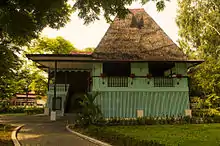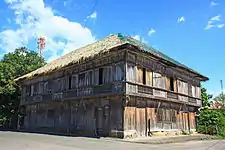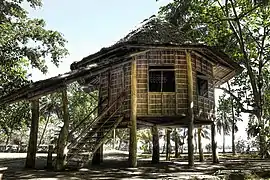| This article is part of a series on the |
| Culture of the Philippines |
|---|
 |
| Society |
| Arts and literature |
| Other |
| Symbols |
|
Philippines portal |

.jpg.webp)
The bahay kubo, kubo, or payag (in the Visayan languages) is a type of stilt house indigenous to the Philippines.[1][2] It often serves as an icon of Philippine culture.[3] The house is exclusive to the lowland population of unified Spanish conquered territories. Both the torogan and its design heavily influenced the colonial-era bahay na bato architecture.
Etymology

The Filipino term báhay kúbo roughly means "country house", from Tagalog. The term báhay ("house") is derived from Proto-Malayo-Polynesian *balay referring to "public building" or "community house";[4] while the term kúbo ("hut" or "[one-room] country hut") is from Proto-Malayo-Polynesian *kubu, "field hut [in rice fields]".[5]
The term "nipa hut", introduced during the Philippines' American colonial era, refers to the hut version of bahay kubo. While nipa leaves were the thatching (pawid) material often used for the roofs, not all bahay kubo are huts or used nipa materials.
History
Classical period (pre-Hispanic era)
Distinction between each tribes and cultures' style may have been more visible during the pre-hispanic period. Different architectural designs are present among each ethnolinguistic group in what is now the Philippines and throughout the Southeast Asia and Pacific as part of the whole Austronesian architecture.
They were designed to endure the climate and environment of the Philippines.[6] These structures were temporary, made from plant materials like bamboo.[7] The accessibility of the materials made it easier to rebuild when damaged by a storm or earthquake.[7]

Hispanic era
The advent of the Spanish colonial era introduced the idea of building more permanent communities around church and government centers.
Christianized peoples such as the Tagalogs, Visayans, Ilocanos, Kapampangans, Bicolanos, Cagayanons, Mestizos, Criollos, Chinese and Japanese were send to live in the lowlands. This established a community with most population of Austronesian origin, each having their own distinct traditions of Austronesian architecture, dating back even before the Hispanic period. They collectively evolved their own style of construction that soon became synonymous with Austronesian architecture.
These houses primarily featured the bahay kubo. Appearance varies from simple huts, later known by the Americans as nipa huts, to mansions like bahay na bato. Architectural designs and furnishings varied from standard Filipino, Chinese, Americas, European to eclectic.
The new community also setup made construction using heavier, more permanent materials desirable. Some of these materials included bricks, mortar, tiles and stone.[7]
Finding European construction styles impractical in local conditions, Spanish and Filipino builders quickly adapted the characteristics of the bahay kubo and combined it with Spanish architectural style.
Bahay na bato

Bahay na bato or Casa Filipino is a torogan and bahay kubo with noticeable Spanish and Chinese influence. Its design evolved throughout the ages but maintained its nipa hut architectural roots. Its most common appearance is like that of stilt nipa hut that stands on Spanish style stone blocks or bricks as a foundation instead of wood or bamboo stilts.
The bahay na bato, followed the nipa hut's arrangements such as open ventilation and elevated apartments. It was popular among the elite or middle class and integrated the characteristics of the nipa hut with the style, culture, and technology of Spanish architecture.[6][8] The differences between the two houses were their foundational materials. The bahay na bato was constructed out of brick and stone rather than the traditional bamboo materials. It is a mixture of native Filipino, Spanish and Chinese influences.
During the 19th century, wealthy Filipinos built houses with solid stone foundations or brick lower walls, and overhanging. Wooden upper story/stories with balustrades. The ventanillas and capiz shell sliding windows were both native Filipino influences to the design. The tiled roof that often replaced the Nipa roof were influenced by the Chinese.[9]
Bahay na bato had a rectangular plan that reflected the Hispano-American Antillean architectural style integrated with traditional Philippine style.[8] Today these houses are more commonly called ancestral houses.
Characteristics

The hut was typically made of local building materials found in nature such as wood, bamboo and cogon grass. Similar to modern Feng shui, vernacular and superstitious reasons for the materials are considered.[10]
The bahay kubo was elevated above ground or water on stilts as protection from pests, predators and floods, and usually consisted of one room where the whole family would dine, sleep and do other household activities; thus, access to the hut was by ladder. The roof was made of palm leaves smoked for waterproofing and consisted of long steep eaves to allow water to flow down more easily. The windows to the hut were large to allow cool air in. Similar conditions in Philippine lowland areas have led to characteristics "typical" of examples of bahay kubo.[11]

Bubong (roof)
The traditional roof shape of the bahay kubo is tall and steeply pitched, with an apex called the "angkub" and long eaves descending from it.[2] A tall roof creates space above the living area through which warm air could rise, giving the bahay kubo a natural cooling effect even during the dry season. The steep pitch allows water to flow down quickly at the height of the monsoon season while the long eaves give people a limited space to move about around the house's exterior when it rains.[2] The steep pitch of the roofs is often used to explain why many bahay kubo survived the ash fall from the Mt. Pinatubo eruption, when more 'modern' houses collapsed from the weight of the ash.[2]
Silong
Raised up on hardwood stilts which serve as the main posts of the house, bahay kubo have a silong (the Tagalog word also means "shadow") area under the living space for a number of reasons, the most important of which are to create a buffer area for rising waters during floods and to prevent pests such as rats from getting up to the living area.[2] This section of the house is often used for storage, and sometimes for raising farm animals,[11] and thus may or may not be fenced off.
Silid (living space)
The main living area is designed to let in as much fresh air and natural light as possible. Smaller bahay kubo will often have bamboo slat floors which allow cool air to flow into the living space from the silong below (in which case the silong is not usually used for items which produce strong smells) A bahay kubo may be built without an atip (ceiling) so that hot air can rise straight into the large area just beneath the roof and out through strategically placed vents.
Dingding (walls)
_1.jpg.webp)
The walls are always of light material such as wood, bamboo rods, or bamboo mats called "amakan", "sawali", or “kalakat” in Cebuano. As such, they tend to let some coolness flow naturally through them during hot times and keep warmth in during the cold wet season.
The cube shape distinctive of the bahay kubo arises from the fact that it is easiest to pre-build the walls and then attach them to the wooden stilt-posts that serve as the corners of the house. The construction of a bahay kubo is therefore usually modular, with the wooden stilts established first, a floor frame built next, then wall frames, and finally, the roof.
Dungawan (windows)

Bahay kubo are typically built with large windows, to let in more air and natural light. The most traditional are large awning windows, held open by a wooden rod.[2] Sliding windows are also common, made either with plain wood or with wooden Capiz shell frames which allow some light to enter the living area even with the windows closed. In more recent decades inexpensive jalousie windows became common.
In larger examples, the large upper windows may be augmented with smaller windows called ventanillas (Spanish for "little window") underneath, which can be opened for ventilation to let in additional air on especially hot days.[2]
Batalan
Some bahay kubo, especially those built for long-term residences, feature a batalan ("wet area" or "pantaw") distinct from other sections of the house—usually jutting out somewhat from one of the walls. Sometimes at the same level as the living area and sometimes at ground level, the batalan can contain any combination of cooking and dishwashing area, bathing area and, in some cases, a lavatory.
Batalan used for cooking and washing dishes were known as banggéra in Philippine Spanish (also banggerahan or pinganan). It is named after the banga earthen water-jars which are placed on a jutting structure of spaced bamboo or wooden slats.[12]
Kamalig
A granary detached from the house where harvested rice is kept.
Construction materials
The walls of the living area are made of light materials. Posts, walls, and floors are typically made of wood or bamboo and other light materials. The thatched roof is often made of nipa, anahaw or some other locally plentiful plant. Thus, making it easier for the nipa huts to be moved if needed.
Cultural significance
A nipa hut is an icon of Philippine culture as it represents the Filipino value of bayanihan, which refers to a spirit of communal unity or effort to achieve an objective.[3][13]

Arts
A famous folk song Bahay Kubo often sung in schools which mentions a small house surrounded by vegetables goes like this:
The song is a generalization of what a nipa hut would have looked like during the pre-colonial era: a house surrounded by locally cultivated plants. This does not take into account the early and diverse variants of native royalties, particularly those of the Mindanao region which has heavy Islamic architectural influences.
Legacy
American architect and engineer William Le Baron Jenney visited the Philippines for three months in 1850.[15][16] He noticed that during a storm, bahay kubo structures are very "light and flexible"; they only seem to dance and sway through storms. This inspired him to emulate the flexibility of bahay kubo in 1879 when he built the first lighter building. In 1884, he built the Home Insurance Building in Chicago, the first metal-framed skyscraper in the United States. Because of this, he became known as "The Father of Modern American Skyscrapers", and the Home Insurance building would become the predecessor of all the modern skyscrapers in the world.
The bahay kubo also inspired architects such as Francisco Mañosa and Leandro Locsin by incorporating elements of the bahay na bato into their own designs especially seen in Cultural Center of the Philippines, National Arts Center, Coconut Palace, and Light Rail Transit stations.[17]
Similar architecture
Bahay kubo is an example of Austronesian architecture. Other examples of native Austronesian architecture in the Philippines also include structures like the fayu and katyufong of Bontoc; bale and abong of Ifugao; binayon of Kalinga; binangiyan of Kankanai; jin-jin of Ivatan; baley of the Matigsalug; binanwa of Ata; bolloy of Klata; baoy of Ovu-Manuvo; bale of the Bagobo Tagabawa; bong-gumne of Blaan; uyaanan of Mansaka; gunu-bong of T'boli; lawig, mala-a-walai, langgal, lamin and torogan of the Maranao; bay-sinug of Tausug; lumah of Yakan; and others.
See also
References
- ↑ Lee, Jonathan H. X., Encyclopedia of Asian American folklore and folklife, Vol. 1. Santa Barbara, Calif.: ABC-CLIO, 2011. 369. ISBN 0313350663
- 1 2 3 4 5 6 7 Caruncho, Eric S. (May 15, 2012). "Green by Design: Sustainable Living through Filipino Architecture". Philippine Daily Inquirer. Makati, Philippines: Philippine Daily Inquirer, Inc. Retrieved October 16, 2013.
- 1 2 Cruz, Rachelle (August 23, 2013). "THE BAYANIHAN: Art Installation at Daniel Spectrum". The Philippine Reporter. Toronto, Ontario, Canada. Archived from the original on October 21, 2013. Retrieved October 16, 2013.
- ↑ Blust, Robert; Trussel, Stephen (2013). "*balay". The Austronesian Comparative Dictionary: A Work in Progress. Vol. 52. pp. 493–523. doi:10.1353/ol.2013.0016. S2CID 146739541.
{{cite book}}:|journal=ignored (help) - ↑ Blust, Robert; Trussel, Stephen (2013). "*kubu". The Austronesian Comparative Dictionary: A Work in Progress. Vol. 52. pp. 493–523. doi:10.1353/ol.2013.0016. S2CID 146739541.
{{cite book}}:|journal=ignored (help) - 1 2 Kim, Young-Hoon (2013). "A Study on the Vernacular Architecture in bahay na bato, Spanish Colonial Style in Philippines". KIEAE Journal. 13: 135–144 – via Korea Institute of Science and Technology Information.
- 1 2 3 Stott, Philip. "Republic of the Philippines". Oxford Art Online. Retrieved May 25, 2017.
- 1 2 Kim, Young Hoon (2013). "A Study on the Spatial Composition influenced by climatic conditions in 19C Bahay na Bato around Cebu city in Philippines". KIEAE Journal: 29–37. doi:10.5370/KIEE.2012.62.1.029 – via Korea Institute of Science and Technology Information.
- ↑ "5000 years of tiles". Choice Reviews Online. 51 (06): 51–2984-51-2984. January 21, 2014. doi:10.5860/choice.51-2984. ISSN 0009-4978.
- ↑ Castronuevo, Ryan B.; Lim, Roxanne Mae C.; Mediarito, Bryan Christian; Villareal, Kommel; Zapanta, Carmelo Jr. (2020). "A Comprehension of Filipino Feng Shui Beliefs and its Relevance to Philippine Construction" (PDF). International Journal of Civil and Structural Engineering Research. 8 (1): 20–24 – via Research Publish.
- 1 2 Alojado, Jennibeth Montejo. "From Nipa Hut to House of Stone". philippine-islands.ph. Alojado Publishing International. Archived from the original on August 8, 2012. Retrieved October 16, 2013.
- ↑ "banggéra". CulturEd Philippines. Retrieved March 16, 2020.
- ↑ Werth, Brenda G., Imagining human rights in twenty-first-century theater: global perspectives. Basingstoke: Palgrave Macmillan, 2013. 207. ISBN 1137027096
- ↑ "Bahay Kubo (Philippine Kids Song)". Mama Lisa's World. Retrieved July 23, 2015.
- ↑ "Chicago Architecture Center". www.architecture.org. Retrieved March 8, 2021.
- ↑ "William Le Baron Jenney | Encyclopedia.com". www.encyclopedia.com. Retrieved March 8, 2021.
- ↑ Mauricio-Arriola, Tessa (February 20, 2019). "UPDATE: National Artist Mañosa, 88". The Manila Times. Archived from the original on January 9, 2022. Retrieved January 9, 2022.

